Thermo Fisher Scientific PrioCHECK L. Hardjo Ab Plate Kit Operating instructions
- Type
- Operating instructions

For Veterinary Use Only. For In Vitro Use Only.
INSTRUCTIONS FOR USE
PrioCHECK™ L. Hardjo Ab Plate Kit
ELISA for
in vitro
detection of antibodies directed against
Leptospira interrogans
serovar Hardjo in serum and milk of cattle
Catalog Number 7442090
Pub. No. MAN0016801 Rev. D.0
WARNING! Read the Safety Data Sheets (SDSs) and follow the handling instructions. Wear appropriate protective eyewear, clothing, and
gloves. Safety Data Sheets (SDSs) are available from thermofisher.com/support.
WARNING! POTENTIAL BIOHAZARD. Read the biological hazard safety information at this product’s page at thermofisher.com. Wear
appropriate protective eyewear, clothing, and gloves.
Introduction
Leptospirosis is a contagious disease of animals and humans caused by infection with the spirochete Leptospira. The genus Leptospira is at present divided
into two species L. interrogans (parasitic) and L. biflexa (saprophytic). Many serovars appear to have a certain animal species as a natural host, but animals
and humans can be infected with a wide variety of serovars. Leptospirosis occurs worldwide. In many European countries, Leptospira interrogans serovar
hardjo (L. hardjo) is the most common cause of bovine Leptospirosis. The indirect ELISA described by Bercovich et al has been modified into a sensitive,
specific and robust ELISA that is suitable for large scale screening.
The Applied Biosystems™ PrioCHECK™ L. Hardjo Ab Plate Kit can be used for: L. Hardjo eradication programs; Monitoring of the L. Hardjo free status of
cattle herds; Monitoring of L. Hardjo antibody level in cattle after vaccination; Individual and herd diagnosis.
Test principle
The PrioCHECK™ L. Hardjo Ab Plate Kit is an indirect ELISA and detects antibodies (Ab) against Leptospira interrogans serovar Hardjo (L. Hardjo) in
cattle. A microtiter plate is coated with inactivated antigen. Serum and/or milk samples are dispensed in the coated wells of a Test Plate. Antibodies
directed against L. Hardjo that are present in the test sample will bind to the antigen during incubation. The bound antibodies are detected using an
anti-bovine monoclonal antibody conjugated to the enzyme horseradish-peroxidase. Subsequently, the bound Conjugate is visualized by incubation with
the Chromogen (TMB) Substrate. Finally, color development is stopped and measured at a wavelength of 450 nm.
Kit components
50 plate kit for 4400 samples. Store kit at 5±3°C until expiry date. See kit
label for actual expiry date. The shelf life of diluted, opened or
reconstituted components is noted below, when appropriate.
Component
Description
1: Test Plate
Fifty Test Plates are delivered in vacuum bags.
2: Conjugate (30x)
30x concentrated, dilute before use. Three vials, each
containing 10.0 mL of Conjugate.
Diluted conjugate is not stable, prepare just before use.
3: Dilution Buffer (5x)
5x concentrated, dilute before use. One vial contains
500 mL Dilution Buffer.
Shelf life of dilution buffer working solution:
4 hours at 22±3°C.
4: Horse Serum
Ready-to-use. One vial contains 20 mL Horse Serum.
Shelf life Horse Serum: until expiry date at −20°C.
5: Demineralized Water
One vial contains 10 mL Demineralized Water.
6: Washing Fluid (200x)
200x concentrated, dilute before use. Three vials, each
containing 60 mL Washing Fluid.
Shelf life of washing solution: 1 week at 22±3°C.
7: Reference Serum 1
Lyophilized. Five vials, each containing 0.5 mL
Reference Serum 1 (positive control).
Shelf life of reconstituted serum: until expiry date
at −20°C.
8: Reference Serum 2
Lyophilized. Three vials, each containing 0.5 mL
Reference Serum 2 (negative control).
Shelf life of reconstituted serum: until expiry date
at −20°C.
9: Reference Serum 3
Lyophilized. Three vials, each containing 0.5 mL
Reference Serum 3 (weak positive control).
Shelf life of reconstituted serum: until expiry date
at −20°C.
10: Chromogen (TMB)
Substrate
Ready-to-use. Two vials, each containing 500 mL of
Chromogen (TMB) Substrate.
11: Stop Solution
Ready-to-use. Two vials, each containing 500 mL of Stop
Solution.
Additional kit contents
• Package Insert
• Certificate of Analysis
Additional material required
Use
Description(1)
Dummy
plates
Dummy plates to make pre-dilutions of the milk and serum samples.
We recommend U-bottom shaped plates (Cat. No. 267245). However,
also other non-binding plates or tubes can be used.
General
Laboratory equipment according to national safety regulations.
Analysis of
results
Plate Reader. The reader has to have an appropriate filter set to read
the plates at 450 nm.
Optional
Plate washer.
(1) Unless otherwise indicated, all materials are available through thermofisher.com.
Test procedure
Precautions
• National Safety Regulations must be strictly followed.
• The PrioCHECK™ L. Hardjo Ab Plate Kit must be performed in
laboratories suited for this purpose.
• Samples should be considered as potentially infectious and all items
which contact the samples as potentially contaminated.
Notes
To achieve optimal results with the PrioCHECK™ L. Hardjo Ab Plate Kit,
the following aspects must be considered:
• The Test Procedure protocol must be strictly followed.
• All reagents of the kit must be equilibrated to room temperature
(22±3°C) before use.
• Pipette tips have to be changed for every pipetting step.
• Separate solution reservoirs must be used for each reagent.
• Kit components must not be used after their expiry date or if changes
in their appearance are observed.
• Kit components of different kit lot numbers must not be used together.
• Demineralized or water of equal quality must be used for the test.
Solutions to be made in advance
Dilution buffer working solution
The Dilution Buffer (5x) (Component 3) must be diluted 1:5 in demineral-
ized water (1 part Dilution Buffer + 4 parts demineralized water).
ELISA buffer
Dilute reconstituted horse serum 1:100 in dilution buffer working solution;
e.g. for 1 plate prepare 40 mL (add 400 µL horse serum to 39.6 mL dilution
buffer working solution). The ELISA buffer can be stored up to 4 hours
at 22±3°C.
Conjugate dilution
Dilute the Conjugate (30x) (Component 2) 1:30 in dilution buffer working
solution; e.g. for 1 plate prepare 12 mL (add 400 µL Conjugate to 11.6 mL
dilution buffer working solution).
Note: The working dilution must be prepared just before use.
Reference sera
Reconstitute the sera (Component 7–9) with 0.5 mL Demineralized Water
(Component 5). Reconstituted reference sera are preferably aliquoted and
can be stored at −20°C until expiry date. Mix sera gently after thawing and
do not refreeze.
Washing solution
The Washing Fluid (200x) (Component 6) must be diluted 1:200 in
demineralized water and is sufficient for a final volume of 12 liters
washing solution. Stability of washing solution: 1 week stored at 22±3°C.
Note: Commercial available ELISA washers can be used. If not available,
washing of the plate(s) can be done by dispensing at least 200 µL of
washing fluid to all wells of the plate(s). Subsequently, empty the plate(s)
and repeat as many times as prescribed. It is not necessary to soak the
plate(s) between washings. Tap the plate(s) firmly after the last washing.
Note: See Appendix B for sample preparation procedure and storage.

thermofisher.com/support | thermofisher.com/askaquestion
thermofisher.com
11 November 2022
Pre-treatment of the test plates
Note: Pre-treatment is only necessary when milk samples are tested and
not for serum samples. However, sera may be tested on a pre-treated
plate (test results are not affected).
1. Dispense 100 µL ELISA buffer to all wells of the Test Plate (Component 1).
2. Seal or cover the Test Plate and incubate for 60±2 minutes at 37±1°C.
3. Discard the ELISA buffer and wash the Test Plate 6 times with
washing solution.
Pre-dilution of reference sera and test sera
• Make a 1:20 dilution of Reference Serum 1, 2, 3 and of the test sera in a
dummy plate by mixing 10 µL serum with 190 µL ELISA buffer.
Incubation of test samples
1. In case of testing serum samples, unpack the required number of Test
Plates. In case of testing milk samples use the plates as described
under “Pre-treatment of the test plates”.
2. Dispense 100 µL of ELISA buffer to wells A1 and B1 of the Test Plate
(= blanks).
3. Dispense 90 µL of ELISA buffer to wells C1 to H1.
4. Dispense 10 µL of 1:20 diluted reference serum 1 (= positive control)
to wells C1 and D1. Final serum dilution 1:200.
5. Dispense 10 µL of 1:20 diluted reference serum 2 (= negative control)
to wells E1 and F1. Final serum dilution 1:200.
6. Dispense 10 µL of 1:20 diluted reference serum 3 to (= weak positive
control) wells G1 and H1. Final serum dilution 1:200.
7. When testing serum samples, dispense 90 µL ELISA buffer into the
remaining wells. Dispense 10 µL of 1:20 diluted test sera in each of
these wells. Final serum dilution 1:200. Serum samples can be titrated
by making two-fold serial dilutions in dilution buffer.
8. When testing individual milk samples, dispense 75 µL ELISA buffer into
the remaining wells. Dispense 25 µL of milk sample in each of these
wells of the plate. Final milk dilution 1:4. Take defatted milk sample
from below the creamy layer.
9. When testing bulk milk samples, dispense 100 µL of milk sample into the
remaining wells. Take defatted milk sample from below the creamy
layer.
10. Seal and shake the test plate gently and incubate for 60±5 minutes
at 37±1°C.
Incubation with conjugate and Chromogen (TMB) Substrate
1. Wash the Test Plate 6 times with washing solution.
2. Dispense 100 µL of diluted conjugate to all wells.
3. Cover the Test Plate and incubate for 60±5 minutes at 37±1°C.
4. Wash the Test Plate 6 times with washing solution.
5. Dispense 100 µL of the Chromogen (TMB) Substrate (Component 10)
to all wells.
6. Incubate the Test Plate for 15 minutes at 22±3°C.
7. Add 100 µL Stop Solution (Component 11).
8. Agitate the Test Plate to mix the content of the wells prior to measuring.
Note: Start the addition of Stop Solution 15 minutes after the first well was
filled with Chromogen (TMB) Substrate. Add the Stop Solution in the
same order and at the same pace as the Chromogen (TMB) Substrate was
dispensed.
Reading of the test and calculating the results
1. Measure the optical density (OD) of the wells at 450 nm within
15 minutes of stopping the color development.
2. Calculate the mean OD450 value of the blanks (wells A1 and B1).
3. Calculate the corrected OD450 value of all samples by subtracting the
mean OD450 of the blanks.
4. Calculate the percentage positivity (PP) of the reference samples 2, 3
and the test samples according to the formula given below.
The corrected OD450 values of all samples are expressed as percentage
positivity (PP) relative to the corrected mean OD450 value of Reference
Serum 1 in wells C1 and D1.
PP = (corrected OD450 test sample / corrected OD450 Reference Serum 1) × 100
Result interpretation
Validation criteria
1. The mean OD450 of the blanks (wells A1 and B1) must be <0.150.
2. The corrected OD450 of Reference Serum 1 (wells C1 and D1) must
be ≥1.000.
3. The mean PP of Reference Serum 2 must be <20.
4. The mean PP of Reference Serum 3 must be between 20 and 60.
The above mentioned criteria have to be met in order to validate the
results of test samples.
Note: If the corrected mean OD450 of Reference Serum 1 is below 1.000
possibly the Chromogen (TMB) Substrate solution is too cold. In that case
pre-warm the solution to 22±3°C or incubate up to 30 minutes.
Interpretation of the percentage positivity
Serum samples
PP = <20%
Negative for
L.
Hardjo specific antibodies.
PP = 20%–45%
Inconclusive (antibodies may be present)
PP = >45%
Positive for
L.
Hardjo specific antibodies.
Milk (individual and bulk) samples
PP= <30%
Negative for
L.
Hardjo specific antibodies.
PP = 30%–60%
Inconclusive(1) (antibodies may be present)
PP = >60%
Positive for
L.
Hardjo specific antibodies.
(1) Bulk milk samples with a doubtful test result can be retested in the PrioCHECK™ L.
Hardjo Ab Plate Kit. When an inconclusive result is confirmed it may be followed by
collecting blood samples of the (possibly) infected herd.
Note: Cut off values may need to be refined for the local situation in order to
obtain acceptable percentages of false-positive and false-negative results.
Testing of individual serum samples (1:200 diluted) has preference over
testing of individual milk samples (1:4 diluted), because of non-specific
reactions that incidentally may occur when testing individual milk samples.
Appendix A – References
1. International Leptospirosis Society, First meeting, Nantes, France
9-12 September (1996).
2. OIE Manual of Standards for Diagnostic Tests and Vaccines, Third
Edition (1996).
3. Bercovich Z, Taaijke R, Bokhout BA. Vet Microbiol 21:255–262 (1990).
Appendix B – Sample preparation procedure and storage
Serum
Milk
• Test sera can be
stored at −20°C prior
to testing.
• Test sera have to be
pre-diluted in ELISA
buffer.
• Milk samples can be stored at 5±3°C prior to testing. If
milk samples are not tested within 3
days of collection add
0.02% sodium azide as a preservative.
• The fluid of the milk sample to be tested should be
collected from underneath the creamy layer.
• Milk samples (bulk) undiluted.
• Individual milk samples 1:4 diluted in ELISA buffer.
Customer and technical support
Technical support: visit thermofisher.com/askaquestion
Visit thermofisher.com/support for the latest in services and support,
including:
• Worldwide contact telephone numbers
• Order and web support
• User guides, manuals, and protocols
• Certificates of Analysis
• Safety Data Sheets (SDSs; also known as MSDSs)
NOTE: For SDSs for reagents and chemicals from other manufacturers,
contact the manufacturer.
Limited product warranty
Life Technologies Corporation and/or its affiliate(s) warrant their
products as set forth in the Life Technologies' General Terms and
Conditions of Sale found on Life Technologies' website at
www.thermofisher.com/us/en/home/global/terms-and-conditions.html.
If you have any questions, please contact Life Technologies at
thermofisher.com/support.
Prionics Lelystad B.V. | Platinastraat 33 | 8211 AR Lelystad | The Netherlands
The information in this guide is subject to change without notice.
DISCLAIMER: TO THE EXTENT ALLOWED BY LAW, LIFE TECHNOLOGIES AND/OR ITS AFFILIATE(S)
WILL NOT BE LIABLE FOR SPECIAL, INCIDENTAL, INDIRECT, PUNITIVE, MULTIPLE, OR
CONSEQUENTIAL DAMAGES IN CONNECTION WITH OR ARISING FROM THIS DOCUMENT,
INCLUDING YOUR USE OF IT.
Revision history of Pub. No. MAN0016801 (English)
Rev.
Date
Description
D.0
11 November
2022
Updated the number of Conjugate (30x), Chromogen (TMB) Substrate,
and Stop Solution vials that are provided in the kit.
C.0
03 September
2021
Updated the number of Reference Sera 1, 2 and 3 vials provided in the
kit to five, three and three vials respectively.
B.0
23 September
2020
Updated the number of Reference Serum 1 vials provided in the kit.
A.0 17 February
2020
• New document. Converted the legacy document (PrioCHECK L. hardjo
Ab 7442090 50 plates v3.0_e.doc) to the current document template,
with associated updates to the publication number, limited license
information, warranty, trademarks, and logos.
• Corrected the number of vials of Conjugate (30x) (Component 2) from
one vial to two vials.
Important Licensing Information: These products may be covered by one or more Limited Use
Label Licenses. By use of these products, you accept the terms and conditions of all applicable
Limited Use Label Licenses.
©2022 Thermo Fisher Scientific Inc. All rights reserved. All trademarks are the property of Thermo
Fisher Scientific and its subsidiaries unless otherwise specified.
-
 1
1
-
 2
2
Thermo Fisher Scientific PrioCHECK L. Hardjo Ab Plate Kit Operating instructions
- Type
- Operating instructions
Ask a question and I''ll find the answer in the document
Finding information in a document is now easier with AI
Related papers
-
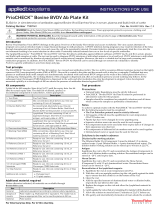 Thermo Fisher Scientific PrioCHECK Bovine BVDV Ab Plate Kit Operating instructions
Thermo Fisher Scientific PrioCHECK Bovine BVDV Ab Plate Kit Operating instructions
-
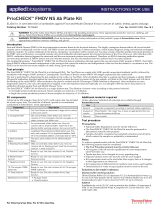 Thermo Fisher Scientific PrioCHECK FMDV NS Ab Plate Kit Operating instructions
Thermo Fisher Scientific PrioCHECK FMDV NS Ab Plate Kit Operating instructions
-
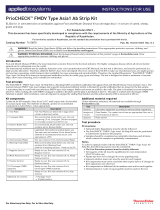 Thermo Fisher Scientific PrioCHECK FMDV Type Asia1 Ab Strip Kit Operating instructions
Thermo Fisher Scientific PrioCHECK FMDV Type Asia1 Ab Strip Kit Operating instructions
-
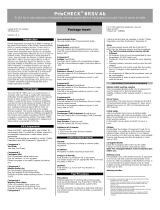 Thermo Fisher Scientific PrioCHECK BRSV Ab serum cattle 7588991 User guide
Thermo Fisher Scientific PrioCHECK BRSV Ab serum cattle 7588991 User guide
-
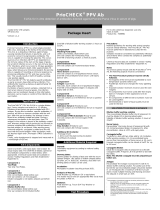 Thermo Fisher Scientific PrioCHECK PPV Ab serum pig 7588981 User guide
Thermo Fisher Scientific PrioCHECK PPV Ab serum pig 7588981 User guide
-
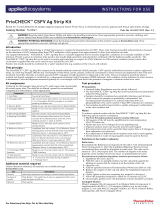 Thermo Fisher Scientific PrioCHECK CSFV Ag Strip Kit Operating instructions
Thermo Fisher Scientific PrioCHECK CSFV Ag Strip Kit Operating instructions
-
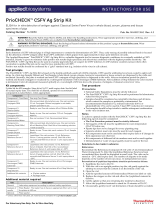 Thermo Fisher Scientific PrioCHECK CSFV Ag Strip Kit Operating instructions
Thermo Fisher Scientific PrioCHECK CSFV Ag Strip Kit Operating instructions
-
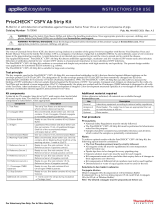 Thermo Fisher Scientific PrioCHECK CSFV Ab Strip Kit User guide
Thermo Fisher Scientific PrioCHECK CSFV Ab Strip Kit User guide
-
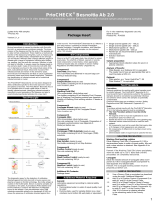 Thermo Fisher Scientific PrioCHECK Besnoitia Ab 2.0 serum plasma bovine 7610530 User guide
Thermo Fisher Scientific PrioCHECK Besnoitia Ab 2.0 serum plasma bovine 7610530 User guide
-
 Thermo Fisher Scientific PrioCHECK Salmonella Ab bovine Dublin plasma serum cattle 7610640 User guide
Thermo Fisher Scientific PrioCHECK Salmonella Ab bovine Dublin plasma serum cattle 7610640 User guide











